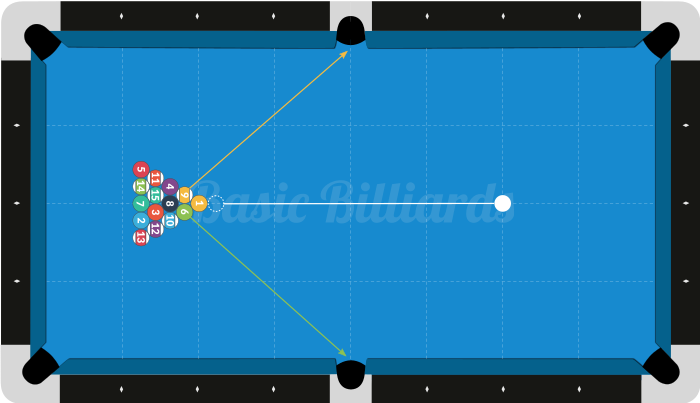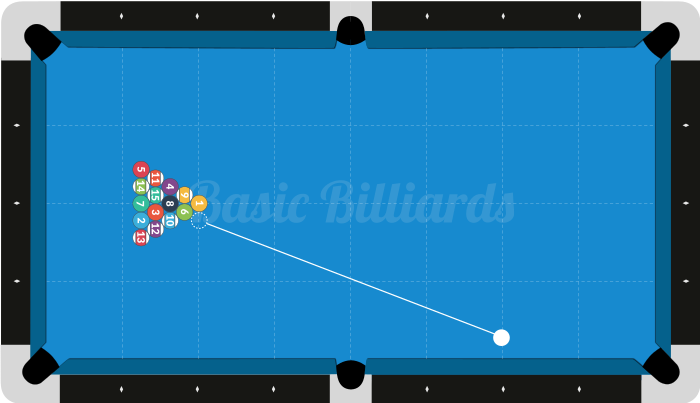8 ball has the most random break of any game in pool because all 15 balls are on the table. However, just like any other shot at the table, you have control over the outcome. The outcome you’re aiming for is to make a ball and have position on a ball in your selected group so you can continue shooting. Straightforward in theory, but difficult in practice. However, with a little knowledge about the break it gets easier to achieve those outcomes.
Goals of the Break
When breaking in 8 ball there are a few specific goals you could have depending on what type of break you’re using. Those goals should be the following:
- Make any ball
- Get a decent spread of the balls
- Lay the cue ball in the center of the table
These are pretty basic goals for every break, but they help explain why you’d choose certain break shots over others. Making a ball is a self explanatory goal, since the object of the game is to make balls in the pocket. Most of the time if you’re making a ball in the pocket off the break you want a good spread. That means no clusters or tight groups of balls collecting together. This makes running out a lot easier when every ball has a pocket and no balls need to be moved.
The last portion of putting the cue ball in the center of the table is useful for getting a good shot after the break. Statistically, the location on the table with access to the most easy shots is the center of the table which is why you should aim to leave the cue ball there every time after the break.
Types of 8 Ball Break Shots
Head Ball Break Shot
The head ball break shot is when you hit the head ball of the rack which is the ball at the top of the triangle, closest to you when you break. This is the most common break shot, and it makes a lot of sense to use it. By hitting the head ball, the cue ball drives as much force as possible through all of the balls.
Making Balls
The strategy to make a ball using this break requires more than just hitting the balls hard. The best place to put the cue ball is close to the center of the table, off to one side by a few inches. This helps direct the most power through the rack. Additionally, if you hit the head ball square, the two balls in the second row have a decent chance of making it into the side pocket. However, they do sometimes get kicked out of the pocket on the way there, but that’s just a part of the luck of the 8 ball break.

Getting a Good Spread
The biggest influencer of the spread with the head ball break shot is where you break from. Generally you want to break from the center because it transfers more power. It also tends to evenly distribute the balls around the table more often than shooting from a side of the table. However, if you’re a player that has good position play and you know your opponent doesn’t have that skillset, this breaking from the side is a good way to throw a curve ball at them. The force of the cue ball drives all the balls towards the opposite side rail which causes those balls to cluster on that side of the table. So if you’re looking to play a more strategic game, then a straight run out when you’re having trouble, moving the cue ball to the side rail isn’t always a bad option.
Controlling the Cue Ball
After the break is over you want the cue ball in the center of the table. To do that, you should hit the head ball as full as possible, and then use a hair of follow on the cue ball to make it stop in the center of the table. If you use only center then the force of hitting the rack will cause the cue ball rebound off the rack and move towards to the opposite end rail. That tiny bit of follow is what will keep it from going that far back. And when I say a tiny bit, I mean no more than a half tip of follow. If you have too much than the cue ball will follow forwards away from the center of the table out of position.
Second Ball Break Shot
While the head ball break is the most popular break shot, under certain conditions, the second ball break is a deadly weapon to use. It has a couple things going for it. First, when using a racking template making the corner ball is easy. Second, this break tends to move the 8 ball on the break, which is good for leagues where making the 8 counts as a win.
Technique
The strategy for this shot is to place the cue ball close to the side rail and aim for the ball in the second row of balls on the side you’re breaking from. You want to hit this ball as full as possible to transfer as much energy as you can. In terms of spin, the cue ball should be hit with low outside spin. Since you can’t hit the second ball completely full, it’s going to travel to the low end of the side rail. To bring it back up near the center, the draw and English help guide the cue ball in the right direction.

Making a Ball
This break is especially useful when you’re playing with a racking template. Racking templates are small rack shaped pieces of thin plastic that the balls rest on top of when racking. These templates are exceptionally effective at ensuring a tight rack with all the balls touching, which is super important for this break to work effectively. When you have a racking template available and use the second ball break you can make the corner ball of the rack go in the corner pocket consistently. The key is to hit the second ball as full as possible, but you can adjust the speed of the break since that will affect the precise direction of the corner ball.
Rules on the Break
It’s tough to keep track of the rules when playing 8 ball so if you’re not sure what the rules are when playing in a bar or somewhere you’re not familiar make sure you establish the rules with the player you’re playing before starting a match. This removes any doubt what the rules of the game are.
Concerning the break, the biggest issues to consider are:
- Whether making the 8 ball counts as a win off the break?
- If a ball is pocketed, is it player choice or take what you make?
- If the cue ball scratches on the break, is it ball in hand behind the line or ball in hand anywhere on the table?
There are many leagues out there such as the APA, BCA, TPA, USAPL, or the WPA just to name a few. They each have their own specific rule set, so there’s no such thing as official 8 ball rules. They literally don’t exist because pool has no singular governing body. If someone tells you different, they either don’t know what they’re talking about or are trying to mislead you in a match.
The best strategy is to get familiar with the rules of the league or tournament you play in and either agree to play by those rules before playing or talk with your opponent about what rules you can agree on. Even though it seems odd, the flexibility in pool is where part of the fun is. You get to play any game you want, as long as you and your partner both agree to play that way. Just make sure to have a brief conversation before playing to make sure everyone’s on the same page.
